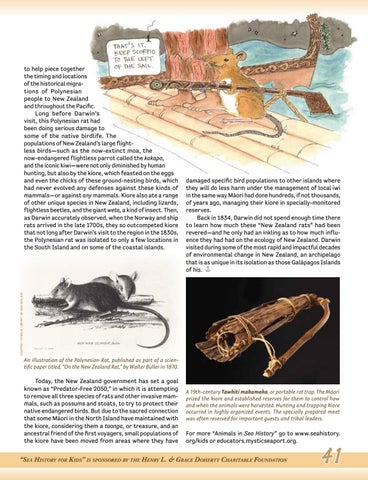damaged specific bird populations to other islands where they will do less harm under the management of local iwi in the same way Māori had done hundreds, if not thousands, of years ago, managing their kiore in specially-monitored reserves. Back in 1834, Darwin did not spend enough time there to learn how much these “New Zealand rats” had been revered—and he only had an inkling as to how much influence they had had on the ecology of New Zealand. Darwin visited during some of the most rapid and impactful decades of environmental change in New Zealand, an archipelago that is as unique in its isolation as those Galápagos Islands of his.
courtesy museum of new zealand
courtesy national library of new zealand
to help piece together the timing and locations of the historical migrations of Polynesian people to New Zealand and throughout the Pacific. Long before Darwin’s visit, this Polynesian rat had been doing serious damage to some of the native birdlife. The populations of New Zealand’s large flightless birds—such as the now-extinct moa, the now-endangered flightless parrot called the kakapo, and the iconic kiwi—were not only diminished by human hunting, but also by the kiore, which feasted on the eggs and even the chicks of these ground-nesting birds, which had never evolved any defenses against these kinds of mammals—or against any mammals. Kiore also ate a range of other unique species in New Zealand, including lizards, flightless beetles, and the giant weta, a kind of insect. Then, as Darwin accurately observed, when the Norway and ship rats arrived in the late 1700s, they so outcompeted kiore that not long after Darwin’s visit to the region in the 1830s, the Polynesian rat was isolated to only a few locations in the South Island and on some of the coastal islands.
An illustration of the Polynesian Rat, published as part of a scientific paper titled, “On the New Zealand Rat,” by Walter Buller in 1870.
Today, the New Zealand government has set a goal known as “Predator-Free 2050,” in which it is attempting to remove all three species of rats and other invasive mammals, such as possums and stoats, to try to protect their native endangered birds. But due to the sacred connection that some Māori in the North Island have maintained with the kiore, considering them a taonga, or treasure, and an ancestral friend of the first voyagers, small populations of the kiore have been moved from areas where they have
A 19th-century Tawhiti makamaka, or portable rat trap. The Māori prized the kiore and established reserves for them to control how and when the animals were harvested. Hunting and trapping kiore occurred in highly organized events. The specially prepared meat was often reserved for important guests and tribal leaders.
For more “Animals in Sea History” go to www.seahistory. org/kids or educators.mysticseaport.org.
“Sea History for K ids” is sponsored by the Henry L. & Grace Doherty Charitable Foundation
41
SEA HISTORY 165, WINTER 2018–19 41
